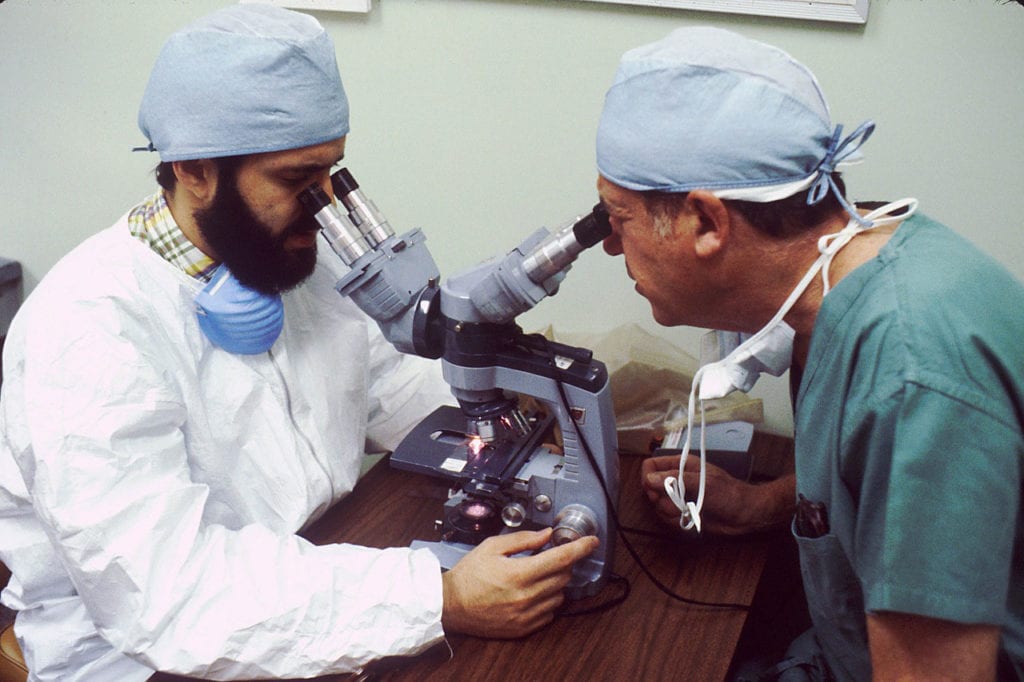

HSCT can improve cognitive outcomes, increase survival, improve growth, reduce facial coarseness and hepatosplenomegaly, improve hearing, prevent hydrocephalus, and alter the natural history of cardiac and respiratory symptomatology. Outcome is significantly influenced by disease burden at the time of diagnosis (and thus, by the age of the individual). Hematopoietic stem cell transplantation (HSCT) for children with severe MPS I. Treatment of manifestations: Infant learning programs/special education for developmental delay physical therapy, orthopedic surgery as needed, joint replacement for progressive arthropathy, atlanto-occipital stabilization spinal cord decompression for cervical myelopathy cerebrospinal fluid shunting for hydrocephalus early median nerve decompression for carpal tunnel syndrome based on nerve conduction studies before clinical manifestations develop special attention to anesthetic risks hats with visors/sunglasses to reduce glare, corneal transplantation for ophthalmologic involvement cardiac valve replacement as needed and bacterial endocarditis prophylaxis for those with cardiac involvement tonsillectomy and adenoidectomy for eustachian tube dysfunction and/or upper airway obstruction ventilating tubes hearing aids as needed CPAP for sleep apnea gastrointestinal management for diarrhea and constipation. This requires detailed clinical and laboratory assessment and can be challenging in very young individuals. Identification of the causative IDUA variants plays an important role in the determination of phenotype.Īn essential component of management is the determination of whether the proband has severe or attenuated MPS I. The diagnosis of MPS I is established in a proband with suggestive clinical and laboratory findings by: detection of deficient activity of the lysosomal enzyme α-L-iduronidase (IDUA) in combination with elevation of glycosaminoglycan levels and/or identification of biallelic pathogenic variants in IDUA on molecular genetic testing. Hearing loss, cardiac valvular disease, respiratory involvement, and corneal clouding are common. While some individuals have no neurologic involvement and psychomotor development may be normal in early childhood, learning disabilities and psychiatric manifestations can be present later in life. The severity and rate of disease progression range from serious life-threatening complications leading to death in the second to third decade, to a normal life span complicated by significant disability from progressive joint manifestations and cardiorespiratory disease. Clinical onset is usually between ages three and ten years.

Without treatment, death (typically from cardiorespiratory failure) usually occurs within the first ten years of life.Īttenuated MPS I. Progressive cardiorespiratory involvement, hearing loss, and corneal clouding are common. Intellectual disability is progressive and profound but may not be readily apparent in the first year of life. By age three years, linear growth decreases. Progressive skeletal dysplasia (dysostosis multiplex) involving all bones is universal, as is progressive arthropathy involving most joints. Gibbus deformity of the lower spine is common and often noted within the first year. Coarsening of the facial features may not become apparent until after age one year. Typical early manifestations are nonspecific (e.g., umbilical or inguinal hernia, frequent upper respiratory tract infections before age 1 year). Affected individuals are best described as having either a phenotype consistent with either severe (Hurler syndrome) or attenuated MPS I, a distinction that influences therapeutic options. While affected individuals have traditionally been classified as having one of three MPS I syndromes (Hurler syndrome, Hurler-Scheie syndrome, or Scheie syndrome), no easily measurable biochemical differences have been identified and the clinical findings overlap.

Mucopolysaccharidosis type I (MPS I) is a progressive multisystem disorder with features ranging over a continuum of severity.


 0 kommentar(er)
0 kommentar(er)
